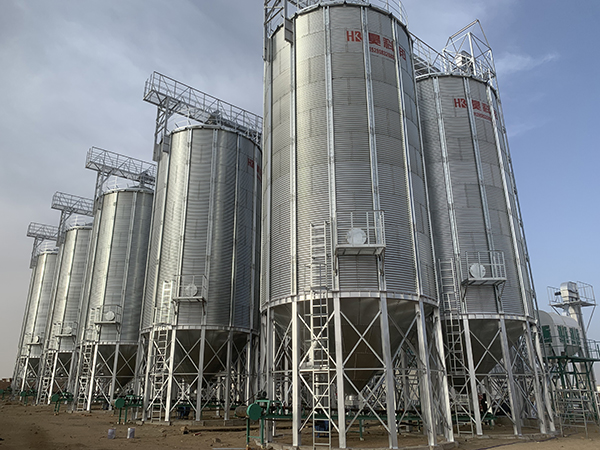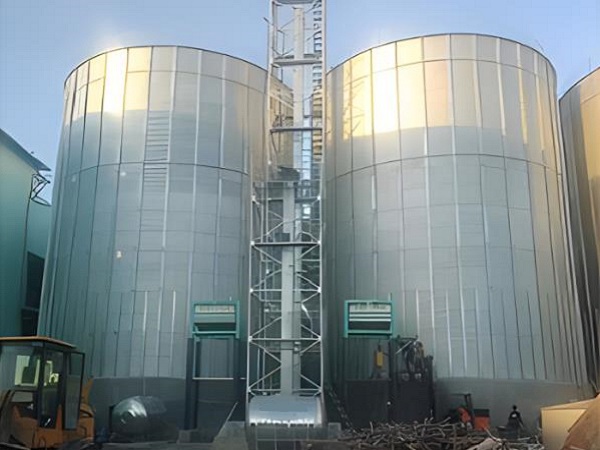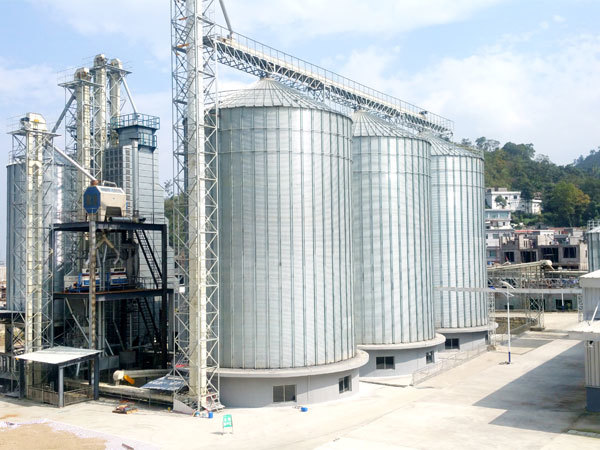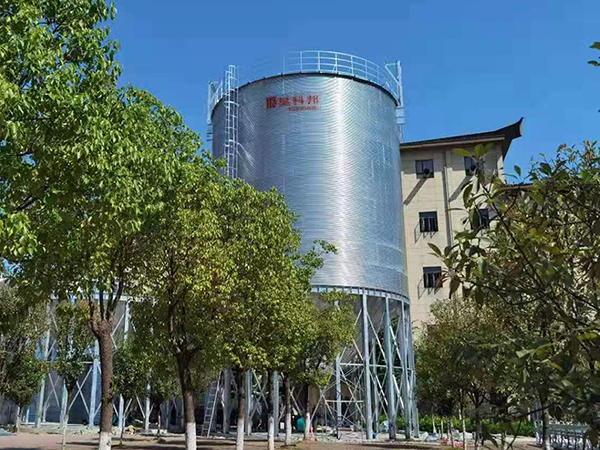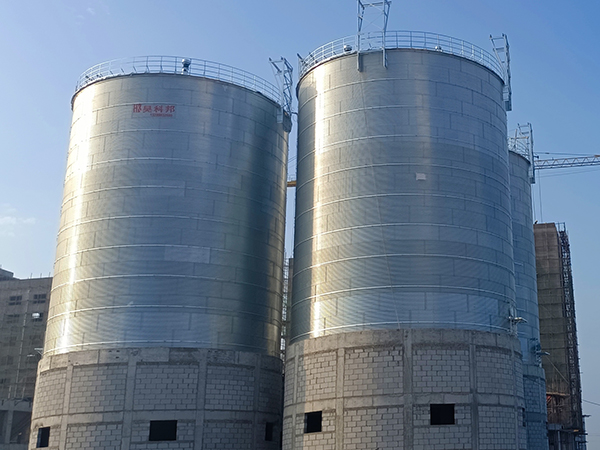300 ton silo
A 300 ton silo is a large metal container specifically designed for storing bulk materials, commonly used in industries such as agriculture
300 ton silo Introduction
A 300 ton silo is a large metal container specifically designed for storing bulk materials, commonly used in industries such as agriculture, food processing, chemical manufacturing, and building materials. It is utilized for the storage of powdered or granular materials like grains (such as wheat and corn), feed, cement, fly ash, and slag micro-powder.

300 ton Silo features
Capacity
The silo is designed with a capacity of 300 tons, meaning it can safely accommodate materials weighing up to 300 tons. This capacity is suitable for medium to large-scale storage needs, aiding in achieving scaled and centralized material management.
Structural Form
The silo typically features an upright steel plate structure, also known as a “vertical silo.” This structure is composed of multiple prefabricated steel plates that are welded or assembled to form a cylindrical or near-cylindrical space. The steel plate surface may have corrugations to enhance structural strength and resistance to deformation.
Silo Diameter
Based on the provided data, the diameter of 300-ton silos varies among different brands. For example, some silos have a diameter of Φ7330mm (approximately 7.33 meters), representing the maximum width of the silo’s cross-section.
Silo Height
The total height of the silo (excluding the foundation) may reach 14335mm (approximately 14.34 meters), covering the main body of the silo as well as the potential space for top equipment (such as ventilation outlets, temperature sensors, etc.).
Internal Structure
The silo may be equipped with material feeding systems, discharging systems, ventilation systems, temperature and humidity monitoring equipment, etc., ensuring smooth material flow, maintaining suitable storage conditions, and effectively preventing condensation and mold.
Grain Storage Method
The silo usually adopts a bulk storage method, where materials are directly piled up inside the silo in a loose form, rather than being stored in packages. This method is beneficial for saving space, reducing costs, and facilitating mechanized operations.
Material and Craftsmanship
The main material of the silo is often galvanized steel plate, a common building steel known for its good mechanical properties and workability. The silo may feature a modular design, with various components prefabricated in the factory and then quickly assembled on-site, which helps to shorten the construction period and improve installation accuracy.
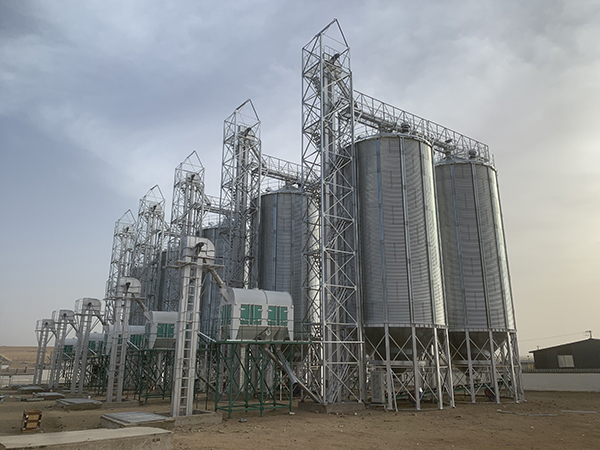
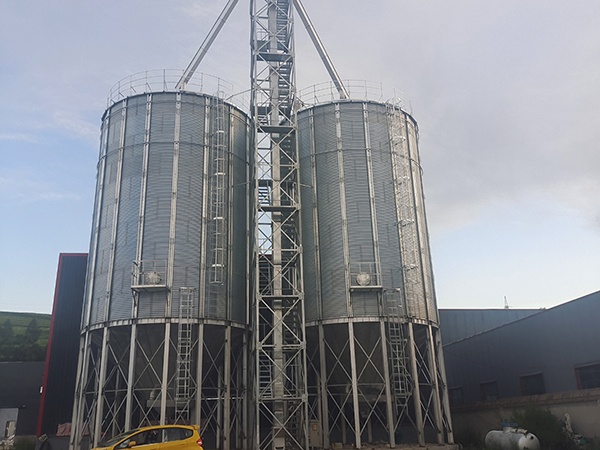
300 ton Silo structure
Silo Body Structure
This forms the main part of the silo, typically constructed from steel plates, which may feature corrugations to enhance strength and stability. The silo body is responsible for containing and securely holding the stored materials.
Base Structure
This includes the foundation and support structure of the silo, ensuring that the silo stands firmly on the ground and withstands the weight of the materials stored inside.
Roof Structure
The top structure of the silo is designed to cover the silo body, protecting the internal materials from external environmental factors such as rainwater and sunlight. The roof may contain ventilation openings or other equipment.
Material Inlet and Outlet Systems
These include the inlets and outlets for materials, as well as associated conveying equipment such as screw conveyors and belt conveyors, used to transport materials into and out of the silo.
Ventilation System
To control the temperature and humidity inside the silo and prevent material deterioration or caking, the silo is usually equipped with a ventilation system, including natural and forced ventilation devices.
Monitoring and Control System
Modern silos may integrate a monitoring and control system, including temperature sensors, humidity sensors, level meters, etc., for real-time monitoring of the conditions inside the silo and making necessary adjustments.
Safety Facilities
These include overflow prevention devices, explosion-proof devices, fire protection systems, etc., ensuring the safe operation of the silo under various conditions.
Accessories and Auxiliary Equipment
Such as ladders, platforms, inspection hatches, etc., facilitating operators to perform routine maintenance and repair work.
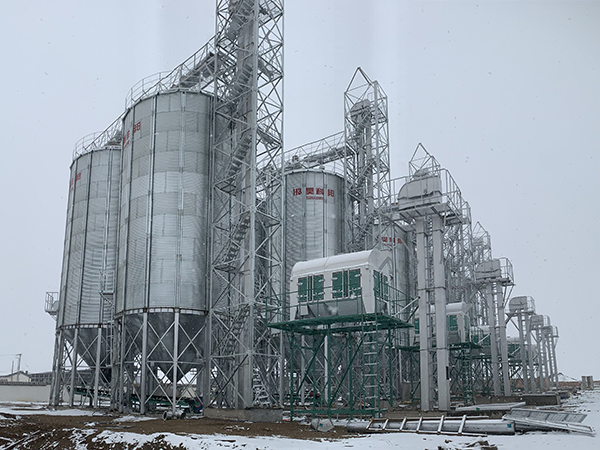
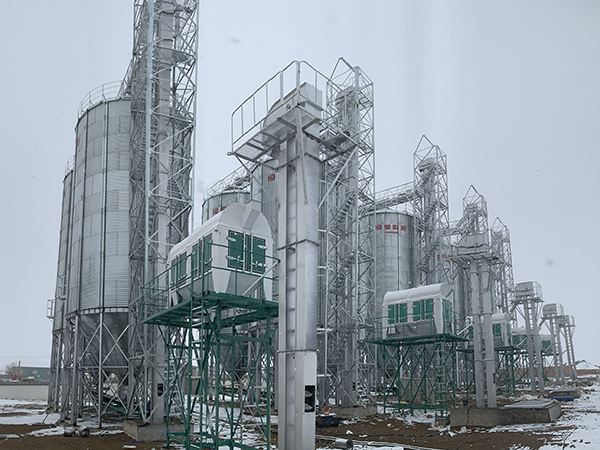
300-ton Silo Advantages
High Storage Efficiency
Compared to traditional flat warehouses with the same footprint, vertical silos, due to their three-dimensional structure, can store more materials within a smaller space, significantly increasing the storage capacity per unit area.
High Space Utilization
Vertical silos extend upwards, conserving valuable land resources. They are particularly suitable for areas with tight land constraints or situations requiring large-scale, centralized storage of materials.
Good Material Protection
The interior of the silo is relatively enclosed, which helps to keep materials dry, reducing the risks of dampness, oxidation, and pollution, thereby ensuring the quality of the materials.
High Degree of Mechanization for Material Handling
Silos are typically equipped with automated in-feed and discharge equipment, facilitating rapid filling and unloading of materials, improving work efficiency, and reducing labor costs.
Safe and Reliable
The design of the silo takes into account structural stability, with strong seismic and wind load resistance capabilities, ensuring safety under various climatic conditions.
Good Ventilation
Vertical silos are often designed with a rational ventilation system, which is beneficial for the expulsion of heat and moisture, helping to maintain a suitable storage environment within the silo and preventing mold.
Environmentally Friendly and Energy-Saving
By optimizing the material handling process and adopting energy-saving technologies, silos can reduce losses during storage and transportation of materials, and decrease energy consumption, aligning with modern green warehousing concepts.
Application scope of 300 ton Silo
Coban Silo is widely used for grain storage such as wheat, corn, soybean, paddy, rice, soybean meal, barley, malt, sunflower seeds, rapeseed, peanuts, flour, and other powder materials, oat, special Silo, and seeds, etc.

300 ton Silo technical parameters
Scientifically speaking, the Silo capacity should be measured with volume (m3). Even in the same grain Silo, the storage tons will be different for different grains with different densities. The following table is calculated based on a Silo density of 0.75kg/m3, and surely HKB customizes Silo systems unique for you.
| Most Popular Hopper Bottom Steel Silo Technical Specifications | ||||||||
| Capacity | 50Ton | 100Ton | 150Ton | 200Ton | 300Ton | 500Ton | 1000Ton | 1500Ton |
| Model | TCZK
03605 |
TCZK
04507 |
TCZK
05507 |
TCZK
06406 |
TCZK
07307 |
TCZK
07313 |
TCZK
11010 |
TCZK
12811 |
| Diameter(m) | 3.667 | 4.584 | 5.500 | 6.417 | 7.334 | 7.334 | 11.000 | 12.834 |
| Total Height(m) | 9.56 | 12.53 | 13.25 | 12.85 | 14.70 | 21.42 | 20.95 | 23.51 |
| Volume(m³)
Density:0.75ton/m³ |
69 | 150 | 222 | 273 | 415 | 699 | 1346 | 2039 |
| Most Popular Flat Bottom Steel Silo Technical Specifications | ||||||||
| Capacity | 1000Ton | 1500Ton | 2000Ton | 2500Ton | 3000Ton | 5000Ton | 8000Ton | 10000Ton |
| Model | TCK
10014 |
TCK
11915 |
TCK
13715 |
TCK
15514 |
TCK
15518 |
TCK
18321 |
TCK
24718 |
TCK
25621 |
| Diameter(m) | 10.084 | 11.918 | 13.750 | 15.584 | 15.584 | 18.334 | 24.751 | 25.668 |
| Total Height(m) | 18.69 | 20.34 | 20.87 | 20.30 | 24.78 | 28.60 | 26.99 | 30.60 |
| Volume(m³)
Density: 0.75ton/m³ |
1335 | 2009 | 2701 | 2467 | 4145 | 6693 | 10879 | 13484 |
After-sale Service
- – HKB provides advanced grain safety storage technology to assure your grain silo 100% quality stability.
- – grain silo Quality guarantee is one year after installation and commissioning or 18 months after leaving China Port. Maturity is the first.
- – 7 days x 24 hours service, within 24 hours reply/solve of any technical issues upon request.
- – Routinely telephone track to remove all might be problems grain silo or issues guarantying the whole system grain silo long-lasting safety and reliability.
- – HKB will consider all other needs like customs clearance, sea delivery, insurance, customs tax benefit plan, documentation, etc. So our respected Users feel so relaxed and easy to get the grain silo system well.

